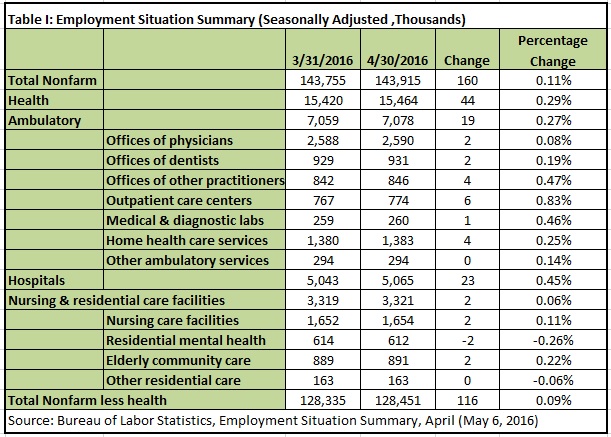 April’s drop in health facilities starts looks to have been idiosyncratic. Health facilities exceeded other construction in May, as in March and February. While construction overall dropped at a seasonally adjusted annual rate of 0.8 percent, health construction increased 0.2 percent (See Table I below the fold).
April’s drop in health facilities starts looks to have been idiosyncratic. Health facilities exceeded other construction in May, as in March and February. While construction overall dropped at a seasonally adjusted annual rate of 0.8 percent, health construction increased 0.2 percent (See Table I below the fold).
The difference was especially apparent in private construction. Construction of private health facilities increased 0.5 percent, 0.8 percentage points more than other private construction, which declined. Construction of public health facilities dropped 1.0 percent, but this was less than half the drop in other public construction.
For the twelve months from May 2015, there is a significant difference in trend between private and public construction. Private construction increased 4.7 percent, and private health facilities starts increased at almost exactly the same rate. However, while public construction declined 2.6 percent, public construction of health facilities dropped only 1.4 percent.
Overall, health construction increased 3.3 percent, versus only 2.8 percent for non-health construction. Notwithstanding other factors, this indicates health costs will continue to increase faster than other sectors of the economy because (as the old saying goes) “a bed built is a bed filled.”
Read More » »
 An advocate of consumer-driven health care, who makes the case that individuals should control most of our health spending directly, will not get very far before hearing the rebuttal: “When you have a heart attack or get hit by a bus, you won’t be in any condition to negotiate which hospital you go to.”
An advocate of consumer-driven health care, who makes the case that individuals should control most of our health spending directly, will not get very far before hearing the rebuttal: “When you have a heart attack or get hit by a bus, you won’t be in any condition to negotiate which hospital you go to.”





